
Michał Walusza / FIDE
FIDE World Cup Quarterfinals: Wei, Sindarov, Esipenko, Yakubboev Through
GM Wei Yi, GM Javokhir Sindarov, GM Andrey Esipenko, and GM Nodirbek Yakubboev are through to the semifinals after having eliminated GM Arjun Erigaisi, GM José Eduardo Martínez Alcántara, GM Sam Shankland, and GM Alexander Donchenko, respectively.Tournament Information
The FIDE World Cup is one of the most prestigious events on the chess calendar. It is the largest knockout tournament and awards three Candidates spots to the first three finishers. 206 players are playing the tournament, with each round only growing in intensity. The time control is 90+30 for the first 40 moves, with an extra 30 minutes after move 40. Matches are played in sets of two: first, a classical portion of 2 games. If the result remains tied, the players play 15+10 games, then, if still tied, 10+10 games, then 5+3, then 3+2, and finally, if still tied, a deciding Armageddon game.
Watch and replay all the games in our broadcast.
Pairings for the Semifinals
The pairings for the semifinals are available here.
Overview
GM Arjun Erigaisi has been eliminated from the World Cup after losing the 15+10 rapid tiebreaks to GM Wei Yi, who briefly had a close to losing position in their second classical game. GM Javokhir Sindarov eliminated GM José Eduardo Martínez Alcántara, also in the rapid tiebreaks, after playing a quiet classical match, and having had to bounce back in the second 15+10 rapid tiebreak game after Martínez won the first. Similar to Sindarov, GM Andrey Esipenko won against GM Sam Shankland in the 10+10 rapid tiebreaks, winning 2-0 against Shankland in that portion of the match. GM Nodirbek Yakubboev clinched victory in the classical segment as he won his first classical game and drew the second against GM Alexander Donchenko.
Interviews
Make sure to check out all of our interviews from the World Cup on our YouTube channel! All our interviews from the quarterfinals are also embedded throughout this article.
GM Arjun Erigaisi vs. GM Wei Yi, Wei Provokes Arjun's Pawns Forward and Infiltrates
 GM Wei Yi vs. GM Arjun Erigaisi; Photo: Michał Walusza / FIDE
GM Wei Yi vs. GM Arjun Erigaisi; Photo: Michał Walusza / FIDE
Following a very quiet game in round 1, where GM Arjun Erigaisi effectively neutralized GM Wei Yi's Ruy Lopez after barely having spent any time, Arjun exerted immense amounts of pressure on Wei's position in round 2. The opening, an Exchange Queen's Gambit Declined, led to the classic Carlsbad pawn structure, where White had good play due to Black's somewhat delayed development. Wei decided to break open the position with 18. c5, but Arjun was ready with the brilliant 20. Qe2!!, which forced Wei to commit an inaccuracy and then an outright blunder. Arjun needed to see 24. Bxd5!, though, with the point being that 24...Qxd5 is met with 25. Rxc3 Ng5! 26. e4!! Rxe4 27. Rd1!, with a forced line that leads to a much better, if not winning, endgame for White. Arjun played 24. Qd2 instead, and after he did not play other moves which could have kept the game going, the game ended abruptly in a draw.
In the rapid tiebreaks, Wei showed exceptional preparation, gaining a huge advantage against Arjun's French Defense as early as move 9. The position continued to get better for Wei, but on move 27, as the position remained highly complicated, Wei started going astray, and soon enough Wei's advantage became only symbolic. Arjun comfortably held a draw, with his pair of bishops stopping Wei's rook and two pawns.
The second rapid game also went Wei's way as he used his trusty Petrov Defense to coax Arjun into pushing pawns and weakening his position. Indeed, Arjun must have felt the need to make use of the White pieces and apply pressure on Wei, but every pawn push only created more holes for Arjun, in due course leading his position to collapse.
Watch our interview with GM Wei Yi:
https://www.youtube.com/watch?v=j_1uNMQtVmM
GM Javokhir Sindarov vs. GM José Eduardo Martínez Alcántara, Sindarov's English Opening Shines
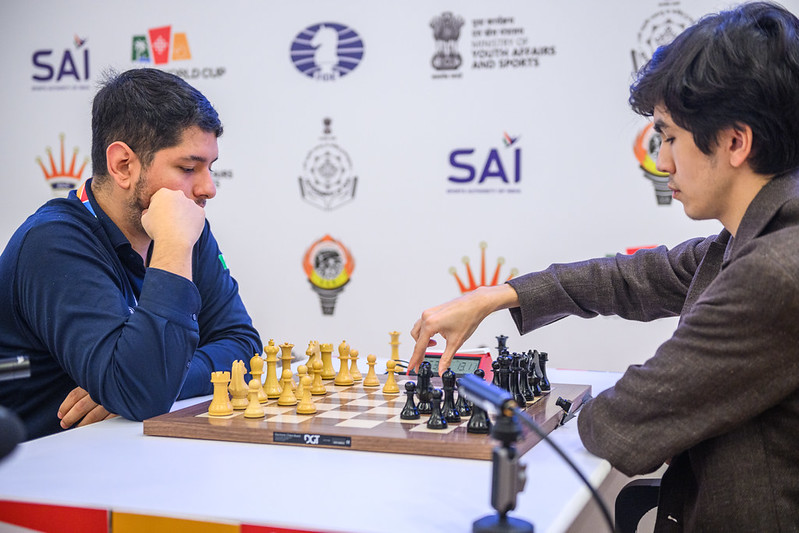 José Eduardo Martínez Alcántara vs. GM Javokhir Sindarov; Photo: Michał Walusza / FIDE
José Eduardo Martínez Alcántara vs. GM Javokhir Sindarov; Photo: Michał Walusza / FIDE
GM Javokhir Sindarov had a pleasant queenless middlegame position against GM José Eduardo Martínez Alcántara's Queen's Gambit Accepted, where he was massaging the position for a while. Martínez held it all together, though, and while Sindarov had minor chances to play more precise moves, a draw was the correct result of the game.
Martínez then played a "memory test" line in round 2 — a forced drawing line, usually with incomprehensible computer moves that seem to be barely working and require memorization. Sindarov's memory did not fail him.
Martínez's strategy to not mind going for the tiebreaks was proven to be wise as his Nimzo-Larsen Attack not only gave him a pleasant position in the first 15+10 game, but also led to victory as his pieces made incursions into Sindarov's position.
Sindarov had to strike back in the second game, and that he did, as Martínez's chosen defense against the English Opening did not produce the desired result. It has to be said that Sindarov had to find some very difficult defensive moves as Martínez sacrificed pieces to get to Sindarov's king.
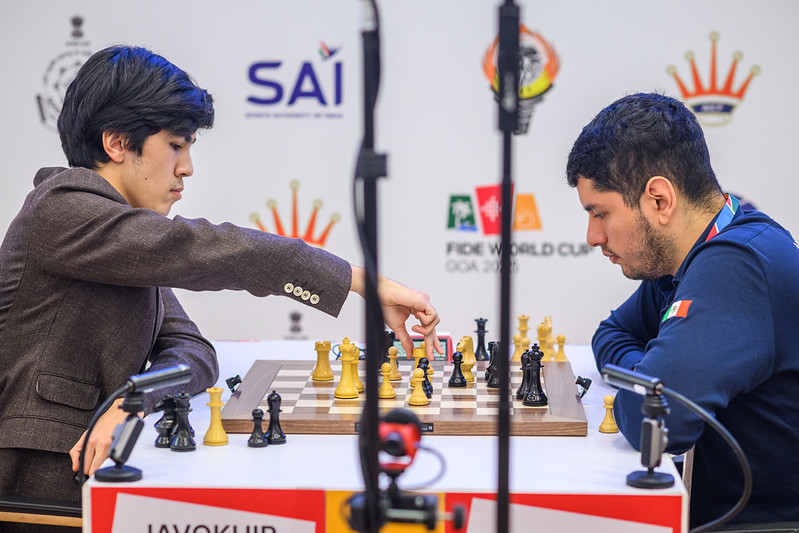
GM Javokhir Sindarov vs. José Eduardo Martínez Alcántara; Photo: Michał Walusza / FIDE
Martínez's Nimzo-Larsen Attack setup, this time starting with the 1. Nf3 move order, did not yield much of an advantage in game 1 of the 10+10 portion. In fact, Martínez was close to lost after 21. Nd2?, but Sindarov eschewed going for a long-term kingside attack with 21...h5, instead playing 21...a6, liquidating pieces and eventually drawing the game.
Sindarov's English Opening once again worked out as planned, despite Martínez having chosen a different Black opening, a Queen's Indian Defense-esque Hedgehog Defense setup, to combat it. A queenless endgame reminiscent of the pair's first classical game was soon on the board, and in contrast to said game, Sindarov found the right setup, pushed his pawns forward, and achieved a winning position. There were some adventures along the way as, in time pressure, Sindarov was not playing the endgame accurately, allowing 55...Bd6, and, earlier in the queenless middlegame, 47...Rb3 (among other moves). After 55...Rc3+ and 56...Bd6, however, Sindarov found the right setup and converted flawlessly.
GM Andrey Esipenko vs. GM Sam Shankland, Esipenko Shows Nerves of Steel
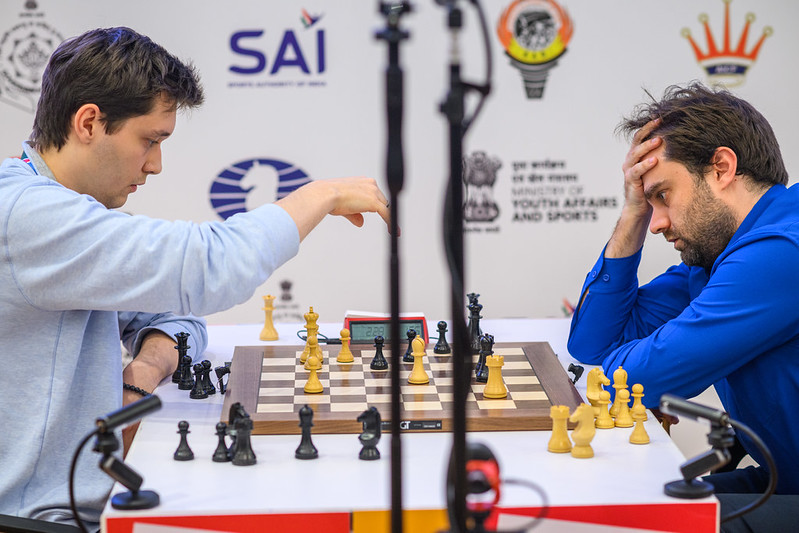 GM Andrey Esipenko vs. GM Sam Shankland; Photo: Michał Walusza / FIDE
GM Andrey Esipenko vs. GM Sam Shankland; Photo: Michał Walusza / FIDE
After a very solid Exchange Queen's Gambit Declined in game 1, GM Sam Shankland showed very creative and novel preparation in the Italian Opening, surprising GM Andrey Esipenko as early as move 3 with 3...d6!?. Esipenko navigated the potential dangers well and chose a sound queenside fianchetto configuration, later on also finding a precise plan to keep his position together and trade pieces.
In the first rapid tiebreak game, Shankland's decision to give up his dark-squared bishop on move 14 with 14. Nf5 came back to bite him later in the game as Esipenko's dark-squared bishop wreaked havoc on White's position; instead, Shankland could have played 14. Be5 to at least force a concession from Black: 14...f6 15. Bf4 Nxf4 16. exf4 is an improved version as compared to the game. While the position on move 41 was technically equal, it was clear that Shankland, with a minute and a half on the clock, was facing a daunting, if not impossible, task to draw the game.
Shankland's Caro-Kann Defense in the next game worked out to perfection as Esipenko was slowly getting outplayed in his chosen Panov Attack variation. Shankland's pieces were far too active, and he was able to use them in exemplary fashion.
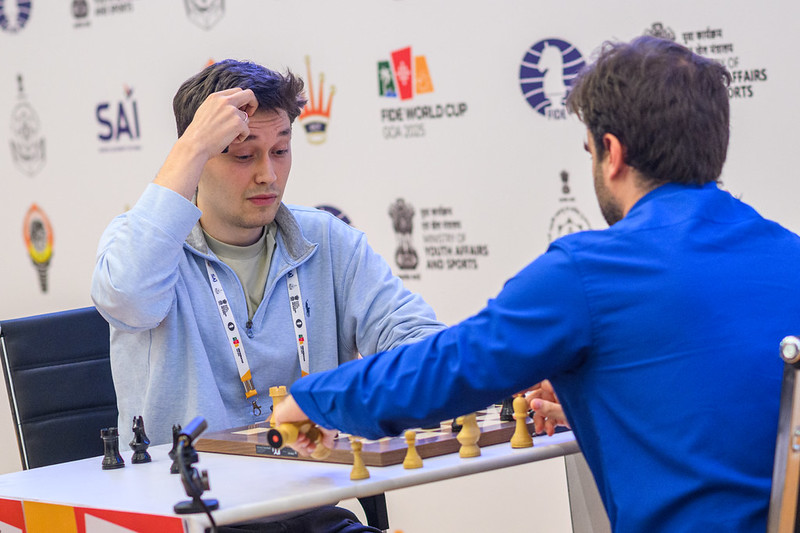 GM Andrey Esipenko vs. GM Sam Shankland; Photo: Michał Walusza / FIDE
GM Andrey Esipenko vs. GM Sam Shankland; Photo: Michał Walusza / FIDE
Esipenko won the first 10+10 game after a sudden blunder from Shankland, though Esipenko, as Black, was pressing for almost the entirety of the game. Spotting the difference between 45. Ke2?? and 45. Kg2!, of course, is no simple task, especially in time pressure.
Esipenko's White game was also dominant as he played an extremely rare opening idea against Shankland's go-to weapon in must-win situations, the Philidor Defense. Esipenko's 5. b3 was indeed clever, but Shankland kept up the pace, not succumbing to the proclivity to take one's time when surprised. Esipenko's space advantage was just too much, however, and after a masterful sequence of trades, Esipenko converted the position into a win without any issue.
Watch our interview with GM Andrey Esipenko:
https://www.youtube.com/watch?v=czlOuCMmVb0
GM Nodirbek Yakubboev vs. GM Alexander Donchenko, Yakubboev's King Marches to Victory
 GM Alexander Donchenko vs. GM Nodirbek Yakubboev; Photo: Michał Walusza / FIDE
GM Alexander Donchenko vs. GM Nodirbek Yakubboev; Photo: Michał Walusza / FIDE
In the only match to finish in the classical segment, GM Nodirbek Yakubboev was able to win the only decisive classical game of the quarterfinals after showing brilliant preparation against GM Alexander Donchenko's Grünfeld Defense. In the aptly named Anti-Grünfeld, Yakubboev walked his king to d1, then to c2, following Donchenko's 11...Qh4+?, which, in retrospect, only helped White coordinate his forces. Yakubboev's king was indeed very safe on the queenside, and Yakubboev's position only improved as Donchenko's pieces looked to be underdeveloped and disjointed. After winning a piece, Yakubboev kept the tactical flare up and decided the game with a nice sequence of forcing moves.
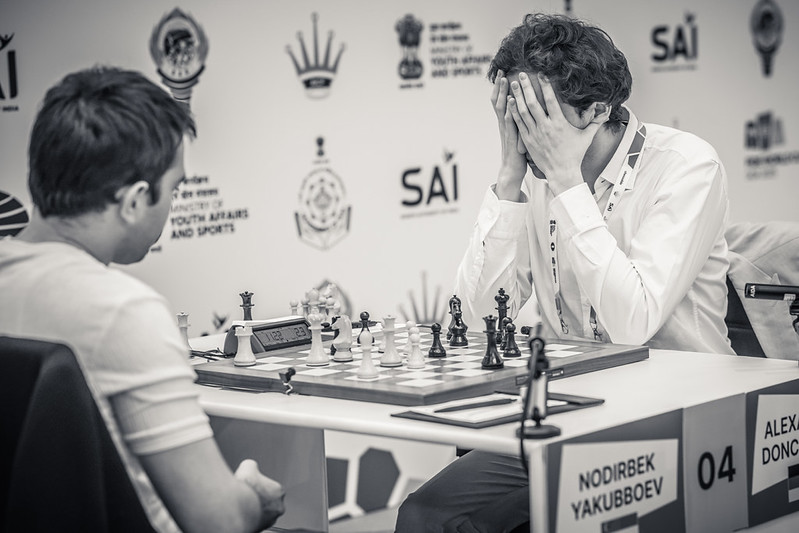 GM Nodirbek Yakubboev vs. GM Alexander Donchenko; Photo: Michał Walusza / FIDE
GM Nodirbek Yakubboev vs. GM Alexander Donchenko; Photo: Michał Walusza / FIDE
Donchenko's attempts to bounce back in the second classical game proved to be futile as Yakubboev clearly knew the intricacies of the notable endgame that arises in the Exchange Queen's Gambit Declined quite well. Donchenko perhaps had one chance to press for an advantage with 20. g4 instead of 20. f3, but there really was not much he could have done differently after the opening.
Watch our interview with GM Nodirbek Yakubboev:
https://www.youtube.com/watch?v=yceeBuovG7s
Simulated Predictions
We once again simulated the tournament outcome a million times, including the results from previous rounds.
- Who is most likely to win the tournament outright?

- Who is most likely to get in the top 3?

- Lineplot Win Probability

Aside from these stats:
- Highest chance to win: 38.9 % (Wei Yi)
- Chances to qualify for the Candidates: 86.2 % (Wei) 79.4 % (Sindarov) 71.3 % (Yakubboev) 63.2 % (Esipenko)
- Chance of an Indian player winning: 0 %
- Chance of a German player winning: 0 %
- Chance of an American player winning: 0 %
- Chance of a Chinese player winning: 38.9 % (= Wei Yi win)
- Alliterative* player win: 0 %
- Chance of a sub 2700 winner: 34.1 % (down from 37.3)
- Chance of a sub 2700 qualifier: 100 % (still)
- Chance of 2 sub 2700 qualifiers: 34.4 % (down from 54.9)
*First and last name start with the same letter or sound (e.g. Sam Shankland and Yu Yangyi)
You may also like
 CM HGabor
CM HGaborHow titled players lie to you
This post is a word of warning for the average club player. As the chess world is becoming increasin… Lichess
LichessShould I report this?
Ever encountered a user misbehaving on Lichess? Check out if and how to report them. Lichess
LichessInterview: Ju Wenjun - Women's World Chess Champion 2025
Lichess interviewed GM Ju Wenjun after she won her fifth Women's World Chess Championship title. ChessMonitor_Stats
ChessMonitor_StatsWhere do Grandmasters play Chess? - Lichess vs. Chess.com
This is the first large-scale analysis of Grandmaster activity across Chess.com and Lichess from 200… thibault
thibaultHow I started building Lichess
I get this question sometimes. How did you decide to make a chess server? The truth is, I didn't. Lichess
Lichess